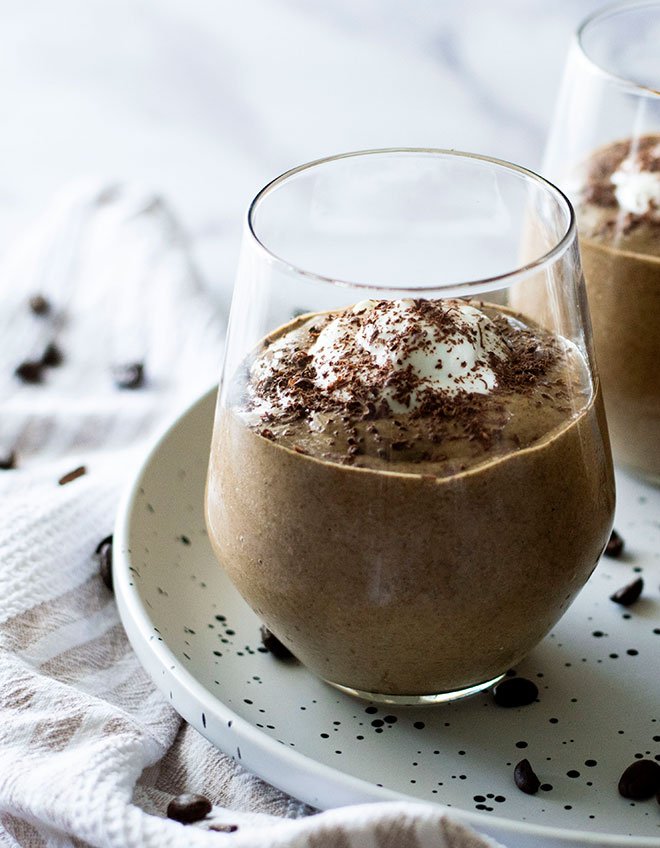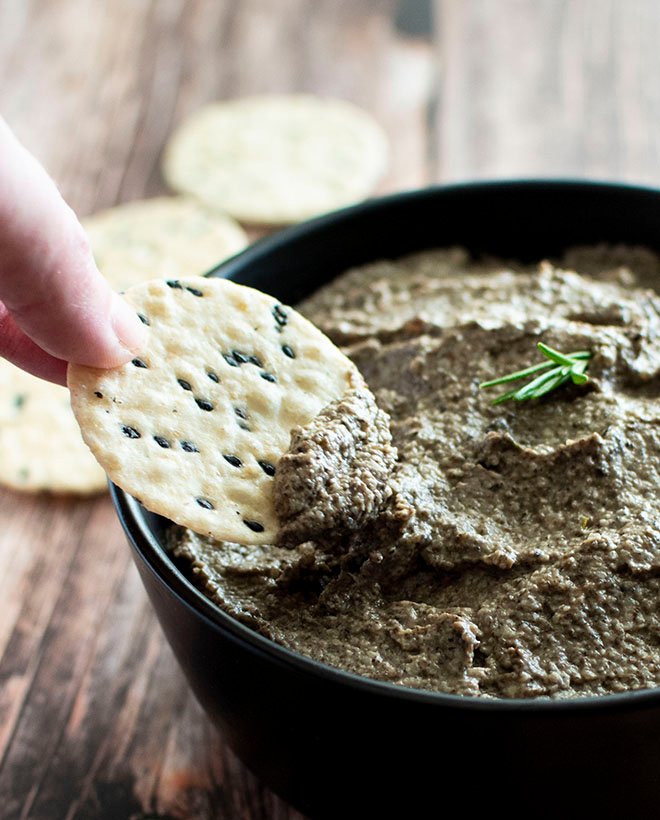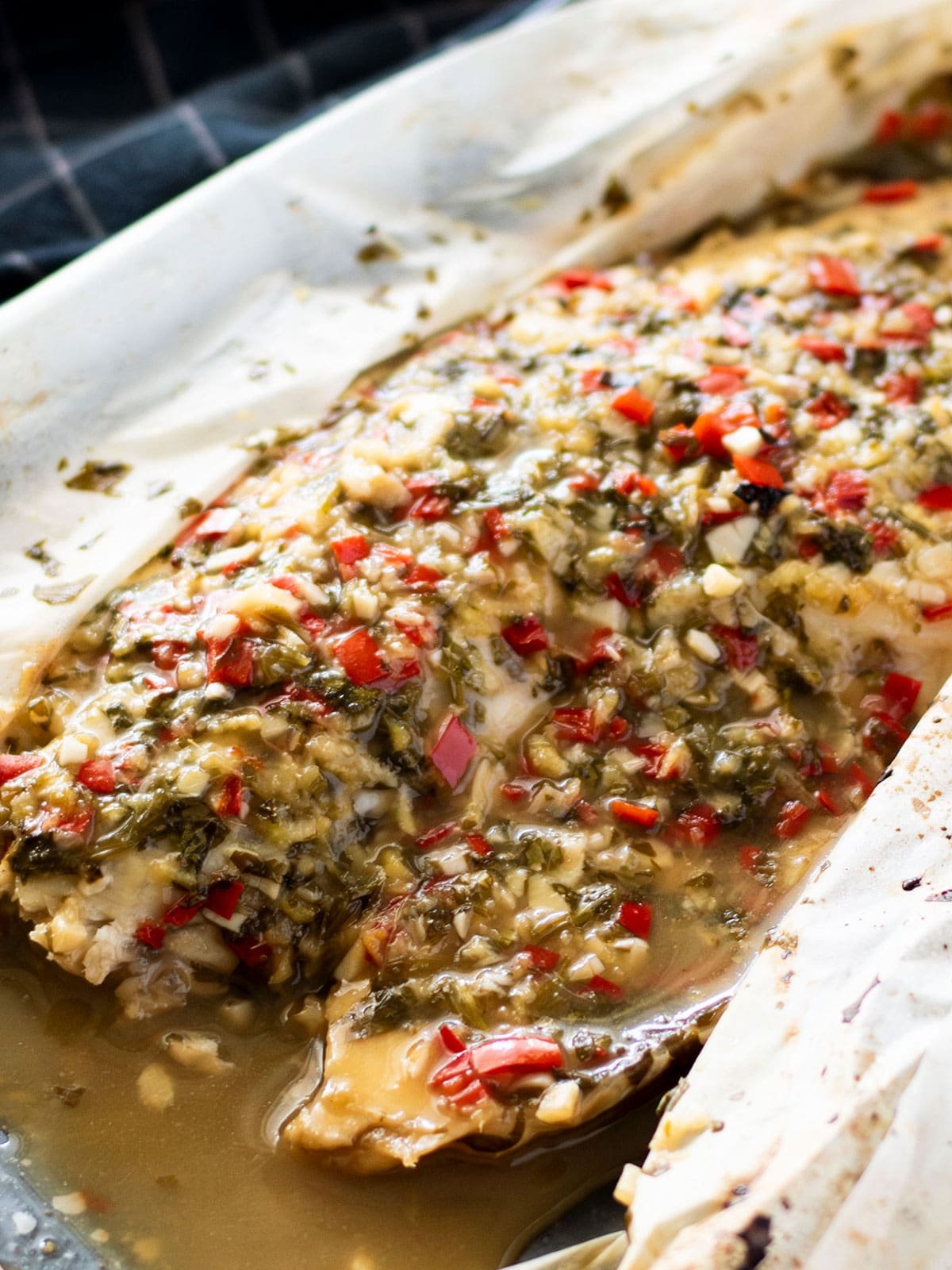Kimchi Fried Rice
Made with egg, vegetables and fiery kimchi, this Kimchi Fried Rice is quick, easy and can be customised to your liking. First, you get the flavours of soy sauce and Chinese five spice, followed by the heat of the kimchi. This straightforward Asian fusion recipe is a tasty and nutritious alternative to takeout.
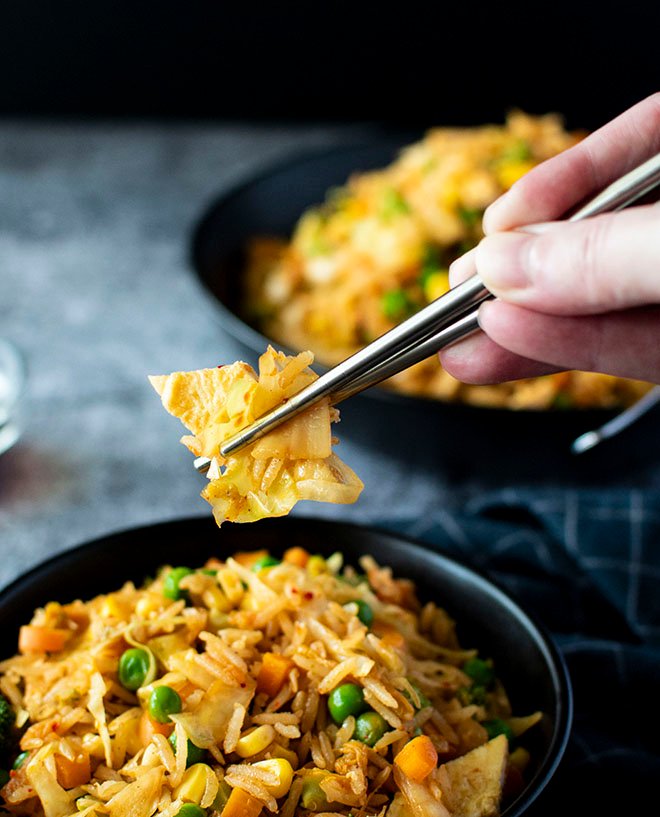
Kimchi Fried Rice
In just 25 minutes, you can have this Kimchi Fried Rice ready for dinner, making it a great midweek meal. Better yet, it will leave you feeling good and satisfied and help keep away snack attacks for the next few hours. You can use whatever vegetables you like, and it tastes absolutely delicious!
While I used a combination of fresh and frozen vegetables, this recipe can easily be made with just frozen vegetables (which are just as nutritious as fresh). However, if you want to use fresh, this recipe is great for cleaning out the fridge! You can also use any proteins you like, such as chicken (e.g. chicken breast or leftover BBQ chicken), beef/pork mince, shrimp/prawns, or even tofu/egg replacer as a vegan option.
Although it doesn’t look like it, the kimchi adds a touch of spiciness, but it won’t blow your head off. It’s more of a mild heat. You can even leave the kimchi out and use this recipe for just plain fried rice. However, you can definitely crank up the heat if you’re a fan of spicy food!
This is the perfect recipe for fans of traditional fried rice who are health-conscious, time pressed and want to jazz it up with a little bit of spice.
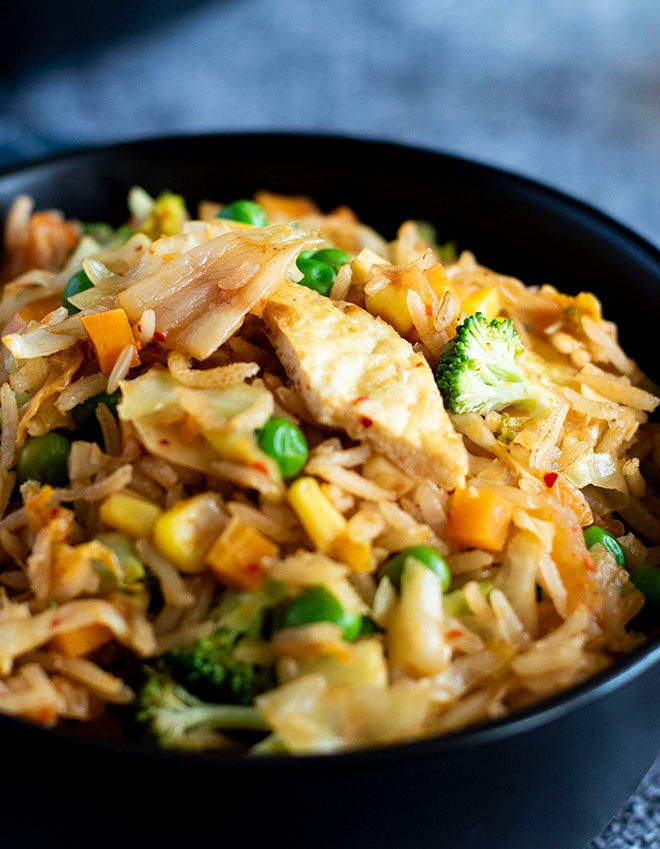
Recipe suitability
Traditional fried rice tends to be relatively high in fat, sodium and low in dietary fibre. This recipe has a moderate amount of dietary fibre, with 6.2g per serve, and combined with a fermented food, makes it a great choice for gut health! It is also high in protein, with 15.6g per serve! While this recipe is low fat (including saturated fat), it is not low in cholesterol or sodium (although much lower than traditional), which means it is not heart friendly. It can be made gluten free, vegetarian or vegan with simple swaps.
What you need for Kimchi Fried Rice

KEY INGREDIENTS
- Kimchi – Tends to be quite high in sodium, as salt is used to brine the vegetables. Where possible, opt for a brand lower in sodium (I used ‘Wicked Kimchi’ from Coles). As a fermented food, kimchi is a probiotic, meaning it contains bacterial cultures that are beneficial for our gut health. Some research suggests that kimchi may also help reduce inflammation and promote heart health.
- Diced vegetables – I used a combination (3/4 cup each) of corn, carrot, peas (frozen) and broccoli (fresh). Carrots, peas and broccoli all contain a decent amount of dietary fibre, which supports our gut health, prevents constipation, and may even help lower LDL (bad) cholesterol levels and regulate blood sugar.
- Green cabbage – I used a green drumhead cabbage. Green cabbage is a fantastic source of vitamin K, which our bodies use to make bone tissue. You might be surprised, but cabbage also has a decent amount of vitamin C, which is used to maintain skin and tissue health and helps our bodies absorb iron better.
- Brown basmati rice – Precooked. Brown basmati rice is a fantastic choice for fried rice as it cooks quickly and dries out fast. It contains more dietary fibre than white rice, which helps to keep us full for longer. It has manganese, which is important for healthy bones, and magnesium, for muscle and nerve function. Brown basmati rice also has vitamins B1 and B3, which our bodies use to convert food into energy.
- Eggs – Sold in cartons labelled as large eggs and are generally 55-60g each (industry standard). Eggs are a fantastic source of protein, which helps maintain and grow our muscles but also keeps us feeling full. They also contain a good amount of vitamin B12, which our body uses to create new cells.
- Soy sauce & oyster sauce – These sauces are very high in sodium. Where possible, choose sauces that are low in sodium (per 100ml) to reduce the overall amount in this dish. I used Jade Pheonix oyster sauce and Lee Kum Kee reduced salt soy sauce, which is much lower in sodium than other supermarket sauces.
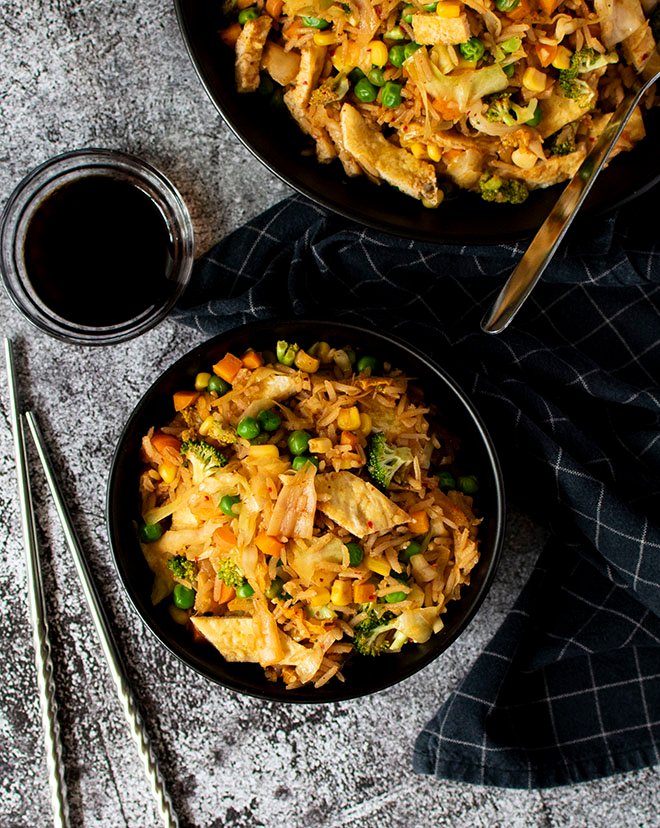
OTHER INGREDIENTS
- Extra virgin olive oil – An excellent healthy fat.
- Garlic – For extra flavour.
- Chinese five spice – A classic in Chinese cooking.
- Sesame oil;
- White pepper;
How to make Kimchi Fried Rice
- Place a fine sieve over a medium bowl. Add the kimchi to the sieve to reserve the juices. Using the back of a metal spoon, press down on the kimchi to extract the remaining juice until no more liquid comes out. Scrape the spoon on the bottom side of the sieve to get any residual drops. Add the other sauce ingredients to the kimchi juice and stir to mix. Put the sauce to the side for later.

- Roughly chop the kimchi and set aside. If not chopped, the kimchi will be in large chunks and not spread evenly through the rice.
- Heat the extra virgin olive oil in a large skillet or wok over high heat. Add the garlic and cook for 1 minute or until lightly golden and fragrant.
- Add the cabbage and any other fresh vegetables to the skillet/wok. Cook for 3 minutes or until the cabbage has wilted and the vegetables have softened. If using frozen vegetables, add to the skillet/wok when the cabbage has wilted and stir to mix.

- Add the cooked rice to the skillet/wok and stir through. Pour the sauce over the rice, stir, and cook for 2 minutes or until all the liquid evaporates. The sauce evaporates quickly, so it is important to stir it through and coat as much rice as possible.

- Push the rice and vegetables to the side of the skillet/wok. Move the skillet/wok so the empty space is over the heating element. Pour the whisked eggs into the empty space and scramble until they are firm and cooked (no soft scrambling). Trust me, this method is much easier and quicker than cooking the eggs into an omelette and then slicing them up (I found this out the hard way). Once the eggs are cooked, stir them through the rice and vegetables.
- Remove the pan from the heat and stir through the sliced spring onions and roughly chopped kimchi. Serve while hot. Enjoy!

Storage
This kimchi fried rice should keep in an airtight container in the fridge for up to 3 days.
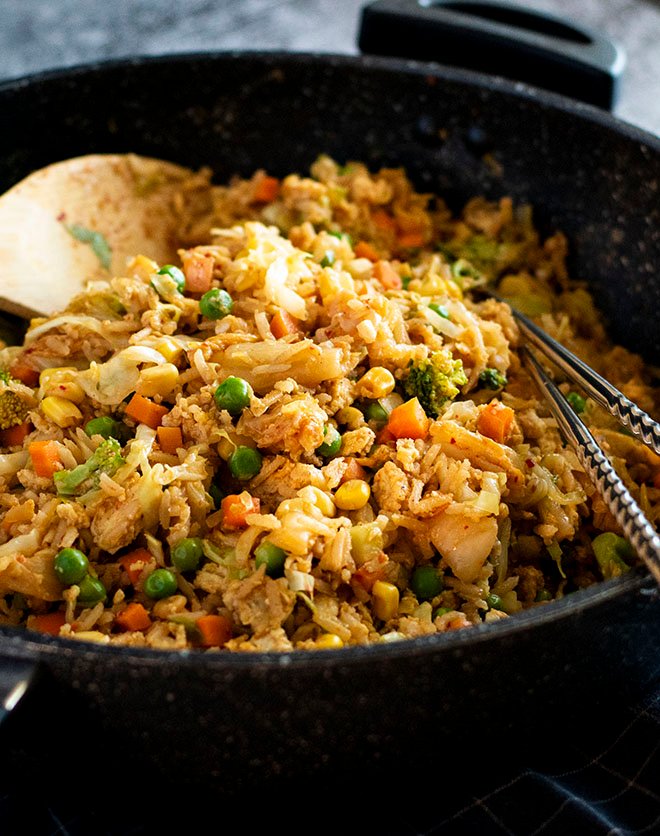
Tips & Substitutes
While the spiciness of the kimchi is mild, it may not be suited to young children or people with poor spice tolerance. If the juice is too spicy, substitute it with ¼ cup of low sodium chicken stock. Or if you want to add more spiciness, I recommend using a low sodium and sugar sambal olek or chilli sauce.
It’s best to cook the brown basmati rice either the night before or at least let it cool before using it in this recipe. Any other variety of rice will need to be laid out in a thin layer on a tray and dried out in the fridge or freezer for 1 day. Also, remember to bring your rice to room temperature before throwing it into the skillet!
I recommend NOT using red cabbage, as it contains a chemical called ‘flavonoids’, which will interact with the egg and and turn your fried rice blue/green! It’s great for a gag, but it looks really unappetising.
In the case of an egg allergy, it can easily be swapped out for other protein options such as a chicken (e.g. poached or BBQ chicken leftovers), ground meats, or even prawns/shrimp. Swap the oyster sauce for the vegetarian version to make this recipe vegetarian friendly. To make this dish vegan, swap out the eggs for firm tofu/egg replacer and regular oyster sauce with a vegan version. Similarly, switch to gluten free sauces (and double check nutrition labels on the kimchi) to make this recipe suitable for people with coeliac disease.
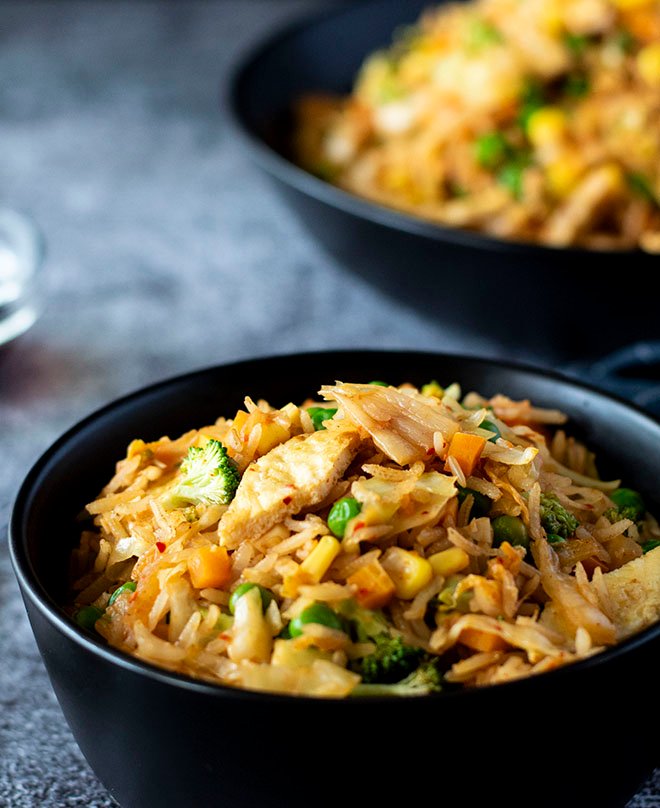
Hungry for more?
Don’t forget to subscribe to my newsletter and follow along on Facebook, Instagram and Pinterest for all the latest updates!
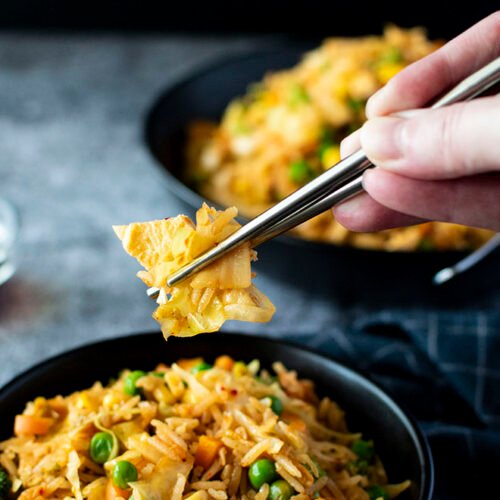
Tap or hover to scale
Ingredients
Sauce
- reserved kimchi juice
- 1 1/2 tbsp soy sauce, salt reduced
- 1 1/2 tbsp oyster sauce
- 2 tsp Chinese cooking wine
- 1 tsp sesame oil
- 1/4 tsp Chinese five spice
- 1 dash white pepper
Fried Rice
- 1 tbsp extra virgin olive oil
- 200 g / 7 oz kimchi, roughly chopped (Note 1)
- 3 cups diced vegetables, fresh / frozen or both (Note 2)
- 2 cups green cabbage, finely shredded (Note 3)
- 2 cups brown basmati rice, cooked (Note 4)
- 5 large eggs, whisked (Note 5)
Instructions
- Place a fine sieve over a medium bowl. Add the kimchi to the sieve to reserve the juices. Using the back of a metal spoon, press down on the kimchi to extract the remaining juice until no more liquid comes out. Scrape the spoon on the bottom side of the sieve to get any residual drops. Add the other sauce ingredients to the kimchi juice and stir to mix. Put the sauce to the side for later.
- Roughly chop the kimchi and set aside. If not chopped, the kimchi will be in large chunks and not spread evenly through the rice.
- Heat the extra virgin olive oil in a large skillet or wok over high heat. Add the garlic and cook for 1 minute or until lightly golden and fragrant.
- Add the cabbage and any other fresh vegetables to the skillet/wok. Cook for 3 minutes or until the cabbage has wilted and the vegetables have softened. If using frozen vegetables, add to the skillet/wok when the cabbage has wilted and stir to mix.
- Add the cooked rice to the skillet/wok and stir through. Pour the sauce over the rice, quickly stir the sauce through and cook for 2 minutes or until all the liquid evaporates.
- Push the rice and vegetables to the side of the skillet/wok. Move the skillet/wok so the empty space is over the heating element. Pour the whisked eggs into the empty space and scramble until they are firm and cooked (no soft scrambling). Once the eggs are cooked, stir them through the rice and vegetables.
- Remove the pan from the heat and stir through the sliced spring onions and roughly chopped kimchi. Serve while hot. Enjoy!
Notes
- Kimchi – Tends to be quite high in sodium, as salt is used as part of the fermentation process. Where possible, I would recommend using a lower sodium variety of kimchi (I used ‘Wicked Kimchi‘ from Coles). Substitute with 1/4 cup low sodium chicken stock if you just want a non-spicy fried rice.
- Diced vegetables – I used a combination (3/4 cup each) of corn, carrot, peas (frozen) and broccoli (fresh).
- Green cabbage – Can be substituted for other types of cabbage, but not red! Red cabbage contains a chemical called ‘flavonoids’, which will interact with the egg and and turn your fried rice blue/green!
- Brown basmati rice – This rice is ideal for fried rice as it dries out quite quickly and has a higher protein and dietary fibre content compared white rice varieties. I would recommend cooking it either the night, or at letting it cool completely before making the fried rice. Any other variety of rice will need to be laid out on a tray and dried out either in the fridge or freezer for 1 day.
- Protein – You can use any proteins you like, such as chicken (e.g. chicken breast or leftover BBQ chicken), beef/pork mince, shrimp/prawns, with or without eggs.
- Vegetarian – Substitute oyster sauce for vegetarian oyster sauce.
- Vegan – Substitute the eggs for tofu/egg replacer, and switch to a vegan oyster sauce.
- Gluten free- Use gluten free soy and oyster sauce.
- Storage – Should keep in an airtight container in the fridge for up to 3 days.
- Nutrition – Calculated per serve, assuming 5 serves.


